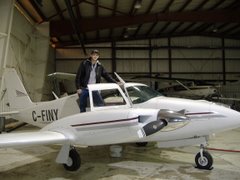Its snowing out right now, and I can't go flying. Flying in the wintertime has both its pros and cons. Airplanes love cold air. Cold air is more dense, which allows the engine to produce more power. The dense air also provides more substance for the propellers and wings to displace, thus giving more thrust and more lift. In the Cessna 150 these effects are most visibly seen during a climb. On a hot summer day with just me in the airplane I can expect around a 3-400 ft/per min climb, whereas in colder winter weather I've see climbs upward of 600 fpm.
Winter flying also requires more cautious actions to avoid airframe icing. Airframe icing is defined as the buildup of ice on the wings and other surfaces of the aircraft, which can add weight to the airplane as well as reduce lift. In icing conditions, ice most heavily builds up on the leading edges of the wings and other surfaces of the airplane. Ice on the windscreen can impede forward visibility from the cockpit. More importantly, icing on the wings, if appropriate action is not taken, can actually bring an airplane down. The ice changes the shape of the wings, which alters how the air flows over it. This can reduce the amount of lift the wings produce.
All of the larger airliners have equipment to defend against icing, and many smaller aircraft have systems as well. There are 3 different types of ice protection systems, categorized into two different groups: De-icing, which is to remove ice that has already built up, and Anti-icing, which works to prevent ice buildup in the first place. De-icing boots are strips of rubber that are glued onto the leading edges of the wings and other flying surfaces. When ice accumulates on the boots, they can be inflated with air which breaks away the the ice so it falls away. This is by far the most common system employed on smaller business jets and piston planes. Less commonly seen is the weeping leading edge system. Like on the Cirrus line of private aircraft, the leading edge has a grid of tiny holes covering the entire leading edge. When activated, these 'pores' seep anti-icing fluid, which is spread by the airflow over the wing. This fluid prevents water droplets from freezing on the wing. Lastly, and only used on jet aircraft, is the hot-wing anti-icing system. The leading edge is heated from bleed air from the jet engines, which prevents icing from freezing onto the leading edges.
Neither of the airplanes I fly are equipped with de-icing, or anti-icing systems. Additionally, neither aircraft perform particularly well with ice, compared to other airplanes. The Cessna 150 is a very small, underpowered airplane. Do to the lack of power, it would not be able to handle the extra weight and decreased lift as well as more powerful airplanes could. The Twin Comanche, though having lots of power, has what is called a laminar flow wing. Simply speaking, it is critical for this type of wing to have a very smooth surface, free of any contamination. Ice on this wing would change the flow of air very drastically. This means that I have to be very cautious as to the weather conditions I fly into, and as such, I am not going flying today.
Thursday, December 7, 2006
Subscribe to:
Post Comments (Atom)




No comments:
Post a Comment